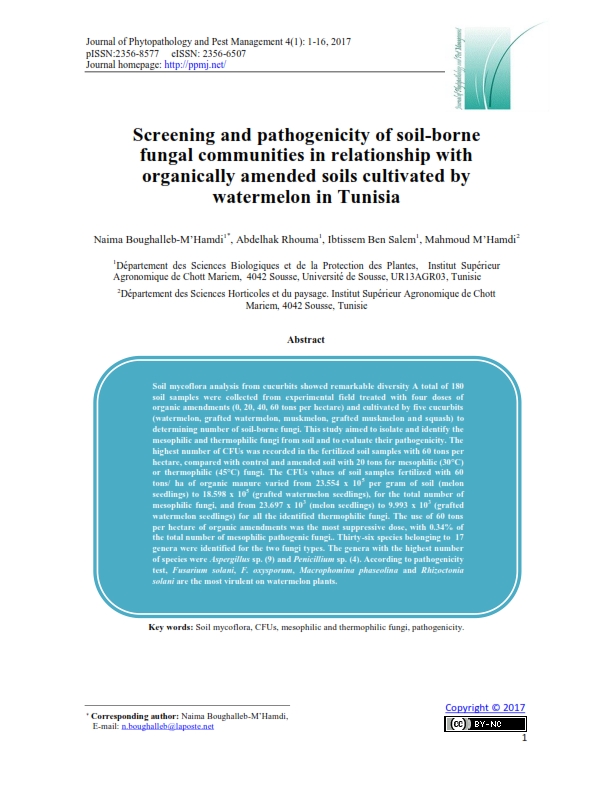Screening and pathogenicity of soil-borne fungal communities in relationship with organically amended soils cultivated by watermelon in Tunisia
Abstract
Soil mycoflora analysis from cucurbits showed remarkable diversity A total of 180 soil samples were collected from experimental field treated with four doses of organic amendments (0, 20, 40, 60 tons per hectare) and cultivated by five cucurbits (watermelon, grafted watermelon, muskmelon, grafted muskmelon and squash) to determining number of soil-borne fungi. This study aimed to isolate and identify the mesophilic and thermophilic fungi from soil and to evaluate their pathogenicity. The highest number of CFUs was recorded in the fertilized soil samples with 60 tons per hectare, compared with control and amended soil with 20 tons for mesophilic (30°C) or thermophilic (45°C) fungi. The CFUs values of soil samples fertilized with 60 tons/ ha of organic manure varied from 23.554 x 105 per gram of soil (melon seedlings) to 18.598 x 105 (grafted watermelon seedlings), for the total number of mesophilic fungi, and from 23.697 x 103 (melon seedlings) to 9.993 x 103 (grafted watermelon seedlings) for all the identified thermophilic fungi. The use of 60 tons per hectare of organic amendments was the most suppressive dose, with 0.34% of the total number of mesophilic pathogenic fungi.. Thirty-six species belonging to 17 genera were identified for the two fungi types. The genera with the highest number of species were Aspergillus sp. (9) and Penicillium sp. (4). According to pathogenicity test, Fusarium solani, F. oxysporum, Macrophomina phaseolina and Rhizoctonia solani are the most virulent on watermelon plants.Â
Metrics

Published
How to Cite
Issue
Section
License
Authors who publish with Journal of Phytopathology and Disease Management agree to the following terms:
- Authors retain copyright and grant the journal right of first publication with the work simultaneously licensed under a Creative Commons Attribution License that allows others to share the work with an acknowledgement of the work's authorship and initial publication in this journal.
- Authors retain copyright and grant the journal right of first publication with the work simultaneously licensed under the Creative Commons Attribution-Non Commercial License (CC BY-NC). This allows others to share the work with an acknowledgement of the work's authorship and initial publication in this journal.
- Archives of Agricultural Sciences Journal is an Open Access Journal, and articles published are distributed under the terms of the Creative Commons Attribution-Non Commercial License (CC BY-NC). Readers may copy, distribute, and display the work for non commercial purposes with the proper citation of the original work. However, the journal retains the right to exploit subsidiary rights on behalf of the authors.
- Authors are able to enter into separate, additional contractural arrangements for the non-exclusive distribution of the journal's published version of the work (e.g. post it to an institutional repository or publish it in a book), with an acknowledgement of its initial publication in this journal.
- Authors are permitted and encouraged to post their work online (e.g., in institutional repositories or on their website) prior to and during the submission process with full disclosure to the journal, as it can lead to productive exchanges, as well as earlier and greater citation of published work. Following publication in Archives of Agricultural Sciences Journal, the author should update the repository, and include a citation and link to the published work.
Click here for more information on Licensing policy
.png)




